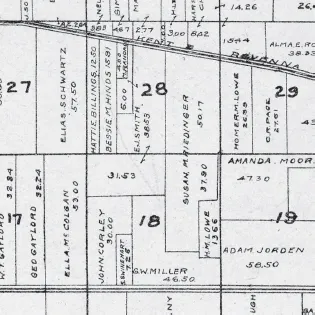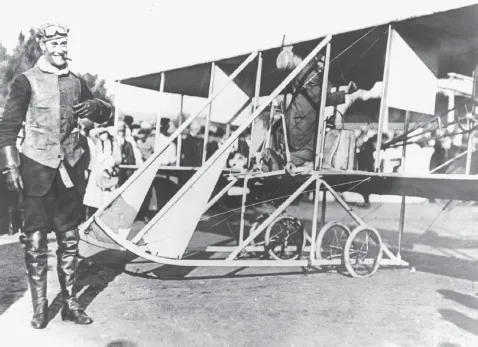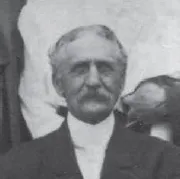![]()
Chapter 1
The Early Years through 1922
Through periods of opportunity and luck that were more than matched with times of difficulty, Andrew W. Paton Field, home to Kent State University’s airport, was part of the region’s aviation narrative and managed to become the longest-surviving public use airport in Ohio.1
In its early years, the field was referred to variously as “Stow Field,” “Stow Aviation Field,” and “Stow Flying Field,” and generically as an airfield, flying field, or landing field. The term “airport” did not come into common usage until the late 1920s and would not be applied to Stow Field’s formal name until it came under Kent State ownership and was renamed Kent State University Airport in 1942.
In 1889, the Reverend Edward J. Smith, a local Methodist minister, began acquiring what was then farmland in Stow Township, Summit County. His first purchases were two parcels from James Season totaling 107.41 acres.2 Over the next thirty years, Reverend Smith bought and sold acreage in these two parcels. His property was bounded on the north by Kent Road (Route 5, now Kent Road/Route 59) and on the south by today’s North River Road.
Reverend Smith created what was considered a model farm that included water, gas, heating, and plumbing. Between 1908 and 1910, he built a large house and barn, making the property readily identifiable in the area. The Akron Beacon Journal society page called the home and grounds “palatial.” Reverend Smith named his property “Kentview” because of its “magnificent view of Kent, especially the new buildings of the Kent normal school.”3
Stow in 1910 was largely rural. The township had a population of 1,173, including the village of Silver Lake. The center of town was Stow Corners, located at the intersection of Kent Road and Hudson Road to the north (today’s Darrow Road/Route 91). Interurban railway service connected Stow to Akron and Silver Lake Park to the west and to Kent and Ravenna to the east. The entire interurban rail system provided access to Cleveland to the north; Canton, Massillon, and New Philadelphia to the south; Wadsworth to the west; and Alliance and Warren to the east.4
Residents learned of the Wright brothers’ historic flight at Kitty Hawk in 1903 from newspaper accounts, which were followed by stories of aviation happenings from all over the country and abroad. But there was little opportunity for local residents to have any direct contact with these new machines. An Akron tailor in 1909 sought to provide some familiarity, however, by announcing through a newspaper advertisement that an exact working model of a Wright brothers’ “aeroplane” could be seen in his display window.5
Parcel map showing land owned by Rev. Edward J. Smith, 1910 (Atlas of Summit County, Ohio, 1910, Archival Services, University Libraries, The University of Akron)
Rev. Edward J. Smith house on the property he called “Kentview,” 1920 (Fran M. Hermance Collection)
Calbraith Perry Rodgers and his Wright EX airplane Vin Fiz. His landing in Franklin Township in September 1911 provided one of the first sightings of an airplane for residents of Portage County. Photo taken at the Chicago International Aviation Meet in August 1911. (Smithsonian National Air and Space Museum [NASM A-42906-A])
In fall 1911, residents anticipated the scheduled overhead flight of Calbraith Perry Rodgers, who was racing to be the first pilot to fly coast-to-coast in less than thirty days. Due to weather, he was forced to make an unscheduled stop on the Alonzo Johnson farm in Franklin Township west of Kent, drawing an excited crowd to see his flying machine. Rodgers became the first aviator to make a transcontinental flight and is recognized as an aviation pioneer for demonstrating the airplane’s potential for travel and commerce.6
Early Airfields
This growing interest in flying prompted some businessmen to see the possibility of a commercial venture, leading to the establishment of the first airport in Summit County in 1912 at Silver Lake Amusement Park, which since 1874 had been a well-established recreational spot. In addition to a flying school, the plan was to manufacture “hydro-aeroplanes and aeroplane supplies.”7 For the July Fourth holiday in 1912, the park promoted its sixty-six-acre airport’s aviation field and aviation exhibition, in addition to its two ballparks, thirty-six amusement departments, Chautauqua, and camping facilities.8
However, in 1913, the Silver Lake operation found itself challenged by three legal battles plus the death of a pilot in a biplane exhibition. In May 1914, another pilot died in an exhibition flight. By July of that year, the aviation business closed down, and all the equipment was sold. The hangars were converted into racehorse barns, and the airfield was turned into ballfields.9 The loss of the Silver Lake Airport left an aviation void in the area. Locals would now be hard-pressed to experience anything aviation-related, while pilots needed an area landing field. Flying safely cross-country required suitable landing areas close enough together to permit stopping as needed, whether planned or due to mechanical or weather issues en route.10
Reverend Smith’s property in Stow is believed to have served as an early landing field, perhaps as early as 1917. Although it has not been possible to substantiate this, it seems plausible given that farmers’ fields were often used, and later descriptions called his field ideal for landing. A record in the Ohio Office of Aviation includes a note that the airfield predated World War I as a “military flying field,” but it gives no details to authenticate this claim.11
Rev. Edward J. Smith (Richard F. Smith Collection)
Rev. Edward J. Smith (1842–1930), the original owner of the property that became the Kent State University Airport, was born in what is now West Virginia. He fought for the Union in the Civil War and suffered as a prisoner in several Southern prisons. Smith went on to receive several degrees, including a doctorate from Wesleyan University. For forty years, he served as a Methodist minister, with pastorates throughout northeast Ohio. When he moved to Stow from Chardon in 1900, he already owned land that he planned to use for general farming, with help from his two sons. Smith built an imposing thirteen-room house on the knoll on his property along with a large barn. He hosted many meetings at his home and was a familiar speaker at patriotic events. In 1906, he was widowed for the second time and, for the rest of his life, shared a residence with his son Fred. In 1919, with the lease of eighty acres to the Ohio Flying School and Transport Company, he relegated farming and airfield issues to Fred. Smith’s first flight was on his eighty-first birthday, followed by many others with pilots from Robbins Flying Service. By 1930, he and Fred had moved to a smaller house on the property, where he watched airplanes taking off and landing from his room. At his death in 1930, Reverend Smith was known as “the flying parson.”12
Aviation Post–World War I
Following World War I, aviation needed to demonstrate it was more than a tool of the military and could play a role in business and civilian life. The establishment of airmail service by the US Post Office proved to be that engine for development. The US Post Office inaugurated airmail service on May 15, 1918, between New York City, Philadelphia, and Washington, DC, with airplanes and pilots from the War Department. On August 12, the post office took over all airmail operations with its own pilots and established a well-run service with remarkable reliability. A transcontinental air route from New York to San Francisco was completed in September 1920. Lacking navigational aids and the needed instrumentation to fly after dusk, the mail was transferred to a train and then picked up at a later destination in the morning by plane. This air-rail combination was twenty-two hours faster than carrying solely by rail.13
The Air Mail Act of 1925, also known as the Kelly Act, was the first federal legislation affecting aviation. It authorized the US Postal Service to award airmail contracts to private carriers and set postal rates. The service was a boon to business, provided a safety net for the developing airline industry, and demonstrated the possibility of reliable air travel and transcontinental flight. Charles I. Stanton, an airmail pilot and later head of the Civil Aeronautics Administration, said of the airmail service: “We planted four seeds.… They were airways, communications, navigation aids, and multi-engined aircraft.… they are the cornerstones on which our present world-wide transport structure is built, and they came, one by one, out of our experience in daily, uninterrupted flying of the mail.”14
At the end of World War I, thousands of military pilots who wished to continue flying returned to civilian life. Surplus military airplanes were plentiful and cheap, leading many young aviators to buy one and endeavor to make a living by moving from one locale to another, offering rides and performing stunts. When business became saturated in one place, they would move on to the next, earning them the initial label of “gypsy fliers” and later of “barnstormers.” During the postwar period, Akron residents saw newspaper advertisements for “aeroplane exhibition flights” and “thrilling stunt flying.”15
The Ohio Flying School at Stow Field
Interest in flying grew. That enthusiasm, plus an economy that had bounced back from a downturn following the end of the war, prompted a group of area men to begin a new aviation enterprise on Reverend Smith’s property. The Ohio secretary of state issued a charter to the Ohio Flying School and Transport Company in October 1919. Of the original investors, only vice president John F. Aston was a pilot, having served in the army air corps as chief instructor. The flying school’s chief pilot was Lt. M. A. C. Johnson, also a flying veteran and former instructor at an army flying school in California.16
Reverend Smith’s last land purchase in May 1919 increased the size of the future airport site to eighty acres. In spring 1920, the Ohio Flying School began erecting an eight-plane hangar in Stow Township, located on “the Smith farm property at Kentview, half way between Kent and Stow Corners.” The field was to serve airplanes of all sizes making intercity or cross-country flights. The hangar, located on the east side of the field, was painted a bright orange to make it more visible to pilots. A service station at the field was to provide needed services for transient...





